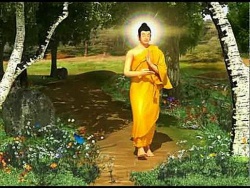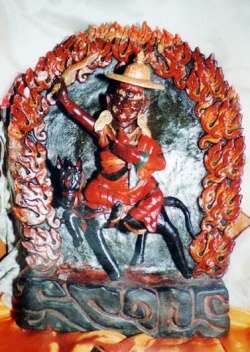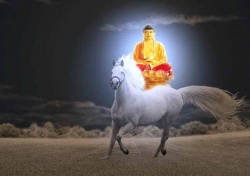Chinese Philosophy: Buddhism
Chinese Philosophy: Buddhism In India, Buddhism was a heterodox religious movement against the authority of the Vedas, the Bible of orthodox Hinduism. Gautama Buddha (c. 563–c. 483 BCE) dismissed the extreme ascetic way of life often adopted by Indian religious believers and taught the middle way.
While Hindu philosophers asserted the existence of atman (I, self, ego, or soul) as the innermost essence of a human being and ontologically identified this essence with Brahma, the absolute reality of the universe, the Buddha repudiated the ideas of atman and Brahma, and proclaimed that everything is causally conditioned and nothing is absolute, permanent, and eternal.
All Buddhists have accepted the Buddha's teaching of anatman (nonself), but have apprehended his philosophical message differently.
For the early, conservative Hinayana Buddhists, the Buddha's denial of ātman implies and even entails the existence of dharmas (divine laws), changing realities of the universe, and impermanent constituents of human beings.
But later, progressive Mahayana Buddhists contended that the concept of dharma is as unintelligible as that of ātman.
Both monistic absolutism and pluralistic realism are extreme views and should be eradicated.
The true teaching of the Buddha is that all things are empty (sunya ).
Both conservative and progressive Buddhist teachings had been introduced to China by the first century CE. The Chinese preferred Mahayana and revered Nāgārjuna (c. 163–263) as the father of Mahayana Buddhism.
The first Mahayana school founded by Nāgārjuna in India was named Mādhyamika, a name derived from the Sanskrit noun madhyamā, meaning middle or neutral.
The Mahayana philosophy of emptiness as the middle way had laid a fine foundation for the development of Buddhism in China.
The creation of new Chinese Buddhist schools—such as Tiantai, Huayan, Chan, and PureLand—was directly or indirectly related to Nāgārjuna's philosophy. The Sanlun Philosophy of Emptiness
In China, Indian Mādhyamika Buddhism is called the Sanlun (three-treatises) School.
Nāgārjuna's Madhya-makārikā (Middle way treatise), Dvādaśanikāyaśāstra (Twelve Gate Treatise ), and [[Śataśāstra] (Hundred verse treatise), with the main verses by Āryadeva (third cent.), are devoted to the philosophy of emptiness and have been emphasized by Chinese Sanlun Buddhists.
For Chinese Sanlun Buddhists, the notions of anatman, the middle way, and emptiness are synonymous in the Buddha's philosophy.
Thus, the Sanlun school is also known as the middle-way school (Zhongdao Zong ) and the emptiness school (Kong Zong ).
More than any other Chinese philosophers, the Sanlun masters had a great interest in logical analysis and logical argument.
They analyzed the dynamic and static worldviews, and they critically examined the nature and function of language and basic linguistic units such as subject, predicate, and predication.
They questioned the essence and use of truth, knowledge, and logic, and they investigated various logical concepts and constructs such as right and wrong, negation and affirmation, and the meaning of thesis, antithesis, and synthesis in rational reasoning and conceptual disputes.
Usually people accept motion or change as an undeniable fact of experience.
Even the Buddha, as well as the Yijing (Book of changes), seems to teach that all things are in a constant state of flux.
Laozi's Daodejing (Way and power classic) also proclaims that "reversing" is the Dao (Way) of heaven.
But under the influence of Indian Mahayana philosophy, Sengzhao (373–414), a brilliant Sanlun philosopher, wrote the famous essay Wu buqian lun (Things do not shift), arguing that motion is empty.
He analyzed motion and pointed out that so-called motion consists of a part that has already passed (yiqu ), a part that has yet to pass (weiqu ), and a part that is passing (qushi ). Change cannot be found in the part already passed, since it is already gone. Nor can it be found in the part yet to pass, since it is not yet.
Nor can it be apprehended in the part that is passing, since passing makes sense if and only if there is an act of passing. But in examining whether there is an act of passing, we cannot use the act of passing to establish an act of passing without begging the question. So motion is impossible.
Zeno, a Greek philosopher, was well known for his argument that motion is impossible. Unlike Zeno, the Chinese Sanlun denial of motion does not entail the affirmation of rest.
For Sanlun Mādhyamika, the concept of rest cannot be established either. Rest is the cessation of motion.
If it is real, it must happen at some place and time. Does rest occur where something has already past, or where something has yet to pass, or where something is passing? None of these can be established. Therefore there can be no rest, or cessation of motion.
For Sanlun masters, motion and rest are both empty, devoid of definite nature or essence, and hence not real.
So one cannot maintain that reality is either permanent or impermanent. Therefore, any substantive or dynamic metaphysics must be repudiated.
According to Chinese Sanlun Mādhyamikas, philosophers appear to be very intelligent, but actually have often been fooled by language.
Both Hindu and traditional Buddhist metaphysicians have failed to see the emptiness of words and names. Laozi understood the inadequacy of human language, as can be seen in the opening to his Daodejing, where he wrote, "The way that can be stated is not the real Way;
Names that can be named are not real names." However, Laozi and later Daoists did not logically analyze language and did not present discursive arguments to substantiate their philosophy.
Following Nāgārjuna's philosophy, Chinese Sanlun masters did logically analyze language, arguing that language is a conceptual game (xilun ).
Sanlun masters critically examined the nature and the structure of conceptual and verbal statements, and argued that the relationship between two basic linguistic units, the subject (kexiang ) and the predicate (xiang ), cannot be rationally well formed, and that predication in our ordinary use of language is really not intelligible.
They studied the precise relationship between the subject and the predicate, examining whether they are identical or different from one another.
On the one hand, if two are identical, they are one, and it makes no sense to call one a subject and the other a predicate. Logically, the sentence is then a tautology and does not say anything about the world.
Hence, in this case, predication is doing no real work. On the other hand, if the subject and the predicate differ, predication is again unintelligible, since being (the similarity of subject and predicate) and not being (the difference between subject and predicate) cannot be at the same place at the same time.
Hence it is absurd to unite what is different to form one sentence describing the same thing. Since every logical or conceptual statement consists of a subject and predicate, reality cannot be intelligently described. Therefore, so-called logic is in essence illogical.
In the view of the Sanlun masters, language and logic are empty. They are conventional and do not have a priori or absolute validity. Words have no definite meaning in themselves.
The meaning of a term is not the object for which it stands, but depends on conditions and circumstances. If conditions change, the meaning of the word changes and might even be lost.
For the Sanlun masters, conceptualization, like a fish trap, has no intrinsic value and reality by itself, though it does have a practical use and can be employed to attract unenlightened persons to Buddhism. Yet the true message of the Buddha's teachings can be properly apprehended only if people comprehend the emptiness of words and discard conceptualization.
Source
http://www.encyclopedia.com/article-1G2-3446800351/chinese-philosophy-buddhism.html





